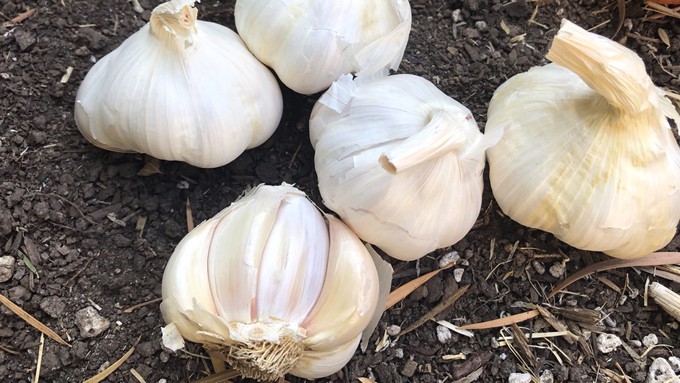
Keeping pests away, the stinky plant makes a great companion to other vegetables

Garlic is a natural pest deterrent as well as a culinary delight. Kathy Morrison
Get a head start on a more flavorful 2023 – and protection for your vegetable garden from pesky pests. Plant garlic this fall and enjoy its many (fragrant) benefits.
Garlic is now available from such mail-order seed companies as Peaceful Valley Farm and Garden Supply in Grass Valley as well as local nurseries. It can be planted from October through December for harvest next summer, though earlier is better.
Garlic ranks as the most popular vegetable to plant among American gardeners, according to recent surveys. Why? We eat a lot of it, on average 2.5 pounds per person each year.
California, which produces most of the nation’s garlic supply, has an ideal climate for this onion cousin. According to UC Davis research, the best varieties to grow in the Sacramento area are “softneck” or silver skin garlics. They put all their energy into producing fat bulbs underground and rarely bolt. The most popular softneck varieties for our climate: California Early and California Late.
“Hardneck” varieties, also called “top-setting garlic,” also grow well in our area. Hardnecks produce a strong stem or scape, which is a spring vegetable all its own. These varieties often have purple or red skins and evocative names such as Purple Italian, Russian Red and Spanish Roja.
In addition to its culinary assets, garlic is a natural pest deterrent. Its scent keeps a wide range of pests away from neighboring plants including codling moths, spider mites, aphids, ants and snails as well as several species of gnats and flies.
Deer and rabbits don’t like garlic either. Planted along the borders of a garden, garlic can form a scent barrier to hungry critters. Garlic builds up sulfur content in the soil, acting as a natural fungicide. But not all vegetables like this extra dose of sulfur. Avoid planting garlic near peas, beans, asparagus, parsley or sage. (It will actually stunt their growth.)
And even though it's a close cousin to onions, garlic shouldn’t be planted in the same spot where onions have grown in the past two or three years; it can pick up diseases or other issues.
For the best crop, garlic needs full sun and good drainage, but not much room or water.
When planting, break the head apart into separate cloves, each with a little bit of the “foot” attached where they were connected. Plant pointy end up, about 2 inches deep. Garlic can be planted only 3 or 4 inches apart. Water once when freshly planted, then let the cloves rest. After they sprout, they need weekly irrigation if there’s no rain.
Baby garlic plants don’t like competition; remove any weeds that try to crowd them out.
For more tips on growing garlic: https://vric.ucdavis.edu/veg_info_crop/garlic.htm
Comments
0 comments have been posted.Sacramento Digs Gardening to your inbox.
Food in My Back Yard Series
May 6: Maintain soil moisture with mulch for garden success
April 29: What's (already) wrong with my tomato plants?
April 22: Should you stock up on fertilizer? (Yes!)
April 15: Grow culinary herbs in containers
April 8: When to plant summer vegetables
April 1: Don't be fooled by these garden myths
March 25: Fertilizer tips: How to 'feed' your vegetables for healthy growth
March 18: Time to give vegetable seedlings some more space
March 11: Ways to win the fight against weeds
March 4: Potatoes from the garden
Feb. 25: Plant a fruit tree now -- for later
Feb. 18: How to squeeze more food into less space
Feb. 11: When to plant? Consider staggering your transplants
Feb. 4: Starting in seed starting
Sites We Like
Garden Checklist for week of May 11
Make the most of the lower temperatures early in the week. We’ll be back in the 80s by Thursday.
* Plant, plant, plant! It’s prime planting season in the Sacramento area. Time to set out those tomato transplants along with peppers and eggplants. Pinch off any flowers on new transplants to make them concentrate on establishing roots instead of setting premature fruit.
* Direct-seed melons, cucumbers, summer squash, corn, radishes, pumpkins and annual herbs such as basil.
* Harvest cabbage, lettuce, peas and green onions.
* In the flower garden, direct-seed sunflowers, cosmos, salvia, zinnias, marigolds, celosia and asters. (You also can transplant seedlings for many of the same flowers.)
* Plant dahlia tubers.
* Transplant petunias, marigolds and perennial flowers such as astilbe, columbine, coneflowers, coreopsis, dahlias, rudbeckia and verbena.
* Keep an eye out for slugs, snails, earwigs and aphids that want to dine on tender new growth.
* Feed summer bloomers with a balanced fertilizer.
* For continued bloom, cut off spent flowers on roses as well as other flowering plants.
* Add mulch to the garden to maintain moisture. Mulch also cuts down on weeds. But don’t let it mound around the stems or trunks of trees or shrubs. Leave about a 6-inch-to-1-foot circle to avoid crown rot or other problems.
* Remember to weed! Pull those nasties before they set seed.
* Water early in the day and keep seedlings evenly moist.